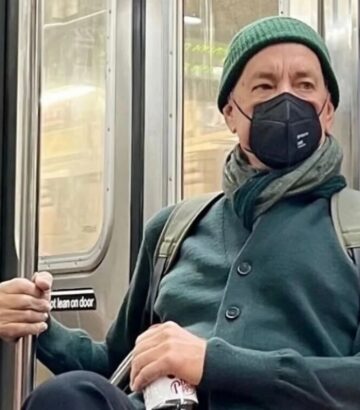COVID-19: “The Elimination of the Virus Is Always Possible”
Interview with Yaneer Bar-Yam
Cécile Philippe, Institut économique Molinari
4/12/22
Yaneer Bar-Yam is a physicist specializing in complex systems. He received his PhD from MIT and was an Associate Professor of engineering at Boston University until 1997 where he explained how current synthetic diamonds could be grown. In 1997 he founded the New England Complex Systems Institute in order to work on real world complex issues. With the pandemic, he co-founded the World Health Network (see declaration in the Lancet) that pursues the work on complex challenges along with the need for mechanisms for galvanizing and empowering communities.
He is a long time collaborator of Nassim Nicholas Taleb working together to explain risk and opportunity and how to understand them in the real world.
CP: You are an expert on complexity science. By its name, people get the idea that it is complicated but they usually have no idea what we are talking about. Could you take us through what is complexity science, situating it in within science?
YBY: I believe that most people have heard about networks, traffic jams and maybe even more about big data. These have become hot topics and they are all part of complexity science. As recently as 25 years ago, in the 90s, complexity was not recognized as being needed. It was believed that the two traditional methods of science, calculus and statistics, were enough in order to understand the world. There was even talk about the end of science, as it was believed that reality could be grasped fully with calculus and statistics and that everything important had been discovered.
However, increasingly it became apparent that these were not enough. Indeed, underlying those tools are assumptions about the world that are not true. Not only are a set of new mathematical methods needed, they are essential to applying science in the context of many critical real world situations, physical, biological, and social.
Along with these methods comes a strategy for describing the properties of elements that make up a system, their individual behavior. What is missing is the ability to describe the dependencies of elements and how they form collective behaviors. To give you examples, these methods miss the behavior of a flock of birds, market crashes, and clothing fads. The collective behaviors of birds and people are of a different nature that need new tools to be understood.
The emblematic example of such a need has been shown in the case of the transition of liquid water to vapor. While there is a smooth relationship between the density of water and temperature before it boils, it then reaches a point where it jumps suddenly, the boiling point. This is the phase transition. Physicists studied the properties near the transition, and they found that the molecules do not behave in the way the calculus and statistics tools predict they should. It is only when physicist Ken Wilson developed a new tool known as renormalization group that it was possible to have concepts describing the reality. The idea of renormalization group is to look at things as a function of scale. The reason is that at that phase transition point, there are fluctuations on all scales—this means that the molecule motions are coupled to each other across the material in a way that violates the assumptions of calculus and statistics. The material is not smooth, as calculus assumes, and the motion of molecules is not independent, as statistics assumes.
What this and related tools enable us to describe is the fact that in many real-world situations, phenomenon emerge and cannot be described by the behaviors of the individual components only. It makes sense that many systems that we care about work this way, from neurons interacting in the brain, to people interacting in societies. The pattern of their interactions is essential to describe. But recognizing that this requires a different kind of mathematics has been less clear. It has been thought that we could just tweak or improve the calculus and statistics way. But it turns out that this is fundamentally not the case. The same thing is true for many macro phenomena emerging from the interdependence of particles, cells, individuals, companies, etc.
CP: Why does it matter?
YBY: It matters immensely because we can get a better understanding of systems, and our whole civilization is based on the well-functioning of the many systems it is composed of. It helps, on the one hand, to grasp how it works but even more important than that, I believe it makes possible to find ways to improve it. Anyone interested in policy issues knows how much time is spent on thinking and working on improving the system. When one does not know what makes it tick, this work is in the dark. Even worse one can miss important fragilities in the system and/or implement solutions that are going to make the problem worse. These are known as “unintended consequences”. It also helps predicting what might happen in a system. This is what we actually did with the Arab spring in predicting that there would be riots, not because of dictators, but because of the food price increases caused by ethanol policies (turning corn into fuel) along with money flows into the commodity markets as a result of the financial crisis. We have done a lot of work in many areas, and one I have been working on for the last 15 years is the field of pandemics. Because I identified a long time ago, a transition to fragility in a highly connected world.
CP: How did you get interested in pandemics?
YBY: We did an analysis of pathogen evolution in the context of increasing global transportation that was published in 2006. Just as with the boiling of water, there is a transition point at which the system goes from local outbreaks to global extinction. That there is a transition means that people would be unprepared for this happening. A sharp transition means that trends would not show that it will happen and all of a sudden, we would be in a regime where we were vulnerable and it would only be a matter of short time that diseases would appear or evolve to exploit that vulnerability with catastrophic consequences. Since then I have been talking about and engaging in outbreak and infectious diseases control, because our ability to prevent extinction depends on taking effective action that addresses that vulnerability. This means that society has to learn to respond, rather than depending on what the disease itself does.
CP: Why do you think that society can do this?
YBY: I marvel at the level of complexity our societies have reached. It gives me hope for the future because if we have reached such a level of complexity, it means that there are some built-in process that make it possible in principle to survive at that level. Still, it does not mean that our current system will necessarily survive. I have even identified reasons that it might not, i.e. if we were not going to be able to fix problems such as pandemics and other challenges inherently constitutive of increasing complexity. One of those is the incapacity of hierarchies or top/down systems of authority to deal with the increased level of information. Networks with their distributed control structure are needed to replace them.
CP: What do you mean exactly by networks? Is it what you are trying to build within this new organization you’ve co-founded called the World Health Network? Why would it work better than other organization similar to it?
YBY: The essential way an effective network works is to have each individual’s capabilities, both talents and knowledge, to be recognized in the role they play. Individuals vary tremendously in the kinds of tasks they do well. Everything a network does can be a distributed property replacing the kind of central authority model that has been used for thousands of years. In recent centuries the debate/conflict of government forms is mostly about how a leader gets into power, e.g. dictatorship, socialism, communism or democracy. A democracy uses a distributed voting process. However, the purpose of that vote is choosing a few individuals to take power. Compare with how the brain works, there isn’t a “master neuron,” there are over a million billion neurons that are all contributing to the way the brain functions. We are working on developing a network based upon enabling individuals to take the role they are best suited to, fulfilling their unique “superpower.” This is consistent with the general tendency of society in recent decades to build on teamwork, and less on leaders.
CP: Why are pandemics such a danger for our civilization?
YBY:
Pandemics are a danger for our societies because there is a risk of ruin or extinction. We need to build robust strategies in order to prevent them.
After two years of COVID this should be obvious to everyone in the long-term consequences of this disease, the next variant, or another disease that might follow soon afterwards. As long as the world is sufficiently separated into local regions, the danger of rapid spread of a deadly disease is minimal. It might happen but happens only rarely, like once in a hundred years. But now with global transportation at the rate it is, there is very little barrier to a deadly disease spreading—unless people react fast to stop it. We are still reacting slowly and not doing what it takes to prevent a disease with a rapid spread and a slow but deadly consequence. We are watching this happen with COVID, and people are aware that it has a certain level of lethality over the short term, but in survivors, infection raises the risk of massive deaths from heart attacks and strokes over multiple years. We haven’t prevented that longer-term consequence from happening and it may very well happen. But even if it doesn’t happen for this disease, there is nothing that prevents it from being true about the next outbreak that happens. If we don’t stop such outbreaks, we will certainly go extinct and it won’t take very long for it to happen. This is also happening in other ways with antibiotic resistant diseases that are becoming more severe over time in recent decades. The same analysis holds. Even currently mild endemic diseases can mutate to become more severe and cause extinction. When a system is inherently vulnerable something will surely happen to exploit that vulnerability.
CP: You advocate for elimination. Why? Is it still a possibility when even the few Western countries doing it have given up in the face of a much more contagious variant like Omicron? Any chance of reaching herd immunity at some point?
YBY: Elimination is possible and has become easier even in the face of the Omicron variant because of technological advances and because of the fact that getting ahead of Omicron causes it to decrease faster than previous variants. The rapid transmission is partly due to the shortening of the time from infection to transmission. If we reduce R to be less than one, the shorter interval means cases go down more rapidly.
In contrast, elimination by herd immunity through vaccination has not been possible because of the high rate of transmission and the inability of vaccination to achieve a sufficiently high prevention of transmission in the face of rapidly mutating virus. Herd immunity by infection has been a terrible strategy from the beginning because it accepts the consequence of infecting many people in diseases, hospitalizations, deaths and chronic illness and disability often called long COVID, injuring the brain, heart and other organs as well as the immune system.
CP: Elimination is seen as the strategy of those who want to lockdown people. Are there other ways? What do you tell people who are exhausted by a two-year fight?
YBY: The objective of elimination is an exit from the pandemic. The only question is whether we will act together to do this. People also think it is very hard to do so, but the issue is putting our minds and determination to this task. Technology and social action work together to make it possible.
For much of the pandemic the main way to achieve elimination has been through strong lockdowns. Even then, the objective of the lockdown is to open up soon, not stay locked down. But today we also have other methods that are easier. With new technology mass testing to stop transmission is now much more practical with the development of low cost and easy to implement RT-LAMP testing.
You are right to mention New Zealand and Australia – the two Western countries that have openly pursued elimination – because for the first two years thanks to their investment in the first lockdown, they have been better on all fronts: mortality, economics, mobility and even liberties. They have had to implement local and short lockdowns when there were local outbreaks, like putting out a fire when it happens, but all in all they have been better off. Much of the western world failed them. Had others done as they did, there would not have been such a risk of importing cases, or new variants. Everyone would have been at elimination and travel would have been possible. It is, of course, immensely difficult to do elimination by yourself, enduring the challenge of new imported cases, the increasing challenge of new variants, and the desire to travel, and the pressure of well-organized groups willing to pursue “normal” lives with no consideration for others and the society at large.
CP: It has become increasingly difficult to follow the flux of information regarding the pandemics. Which variables do you think are the most important ones to focus on at the society level? at the individual level?
YBY: The most essential variables are the number of cases over time—the value of the transmission rate R (or the rate of change in cases per day), and the rate of transmission from community to community (travel). Hidden in the first variable is the discreteness of cases, because the important thing to know is whether we are at zero or not. Zero leads to ability to open up without restrictions. When there are a lot of cases, we feel we are far away, but exponential decline gets us there very quickly if we don’t stop going before we get to the finish line.
CP: Why is it worth saving the system? We get the impression in the Western world that the system is too rotten to be saved and that it might actually be better to let it collapse. What is your take on that?
YBY: The most important thing is not just the system, but also the values that the system represents. Today we see clearly that the value of life and health has been diminished dramatically. People have started to say, ‘well, it doesn’t matter if a few hundred thousand people die.’ That’s a real problem. And it’s not just a problem because of the fact that we’re losing the value of life, which is very bad, but because it is totally counter to the possibility that civilization will be sustained as a complex entity with complex technologies and all the complex supply chains and all the complex collaborations, scientific and literary and other ones we have around the world.
We should surely restore the value of life and go further in recognizing the value of each individual’s life and wellbeing. This goes hand in hand with recognizing the unique capabilities of individuals, quite different from an industrial model where people are seen as commodities like widgets, the same as parts of the machines they make. Statistics and calculus are not well suited to understanding this distinction, but we can see how badly they treat the importance of individuals, and the value of human life and wellbeing.
CP: Final question: when you think about networks, what make you think that life within networks will be better than otherwise. Is it mostly a question of survival against extinction?
YBY: As I mentioned previously, the network as a complex collective should inherently recognize the value of each individual that is part of it. That is integral to how it works.










